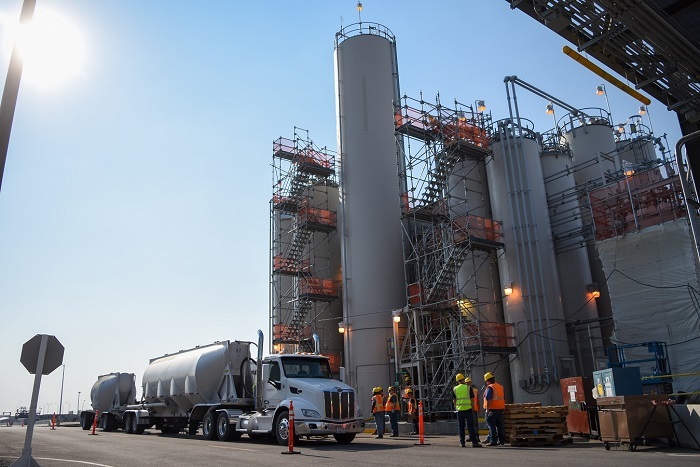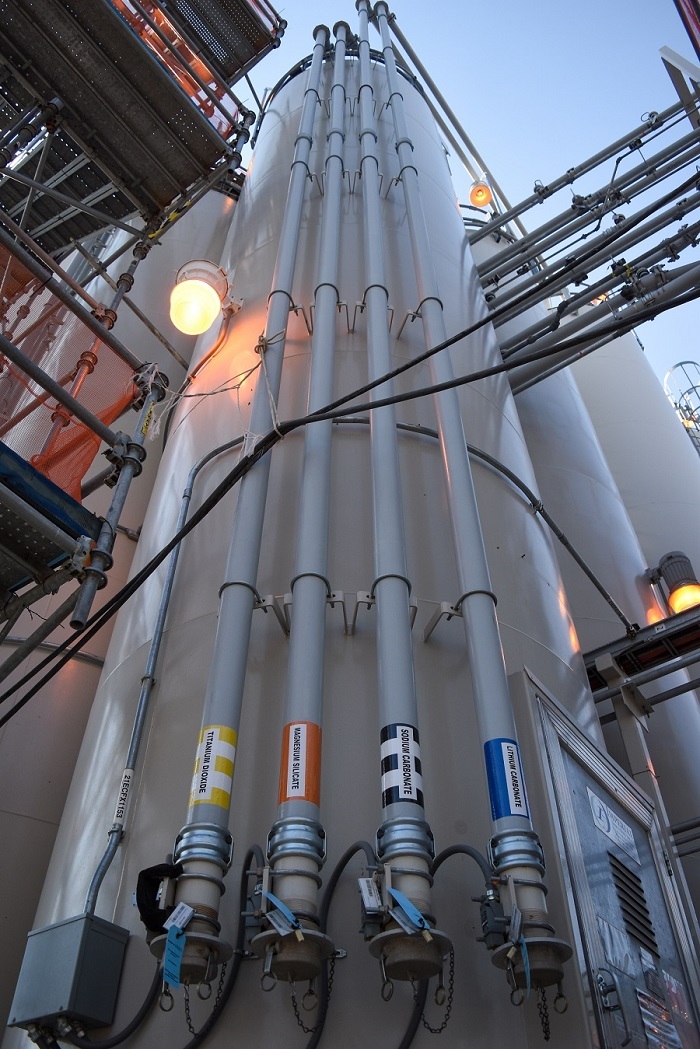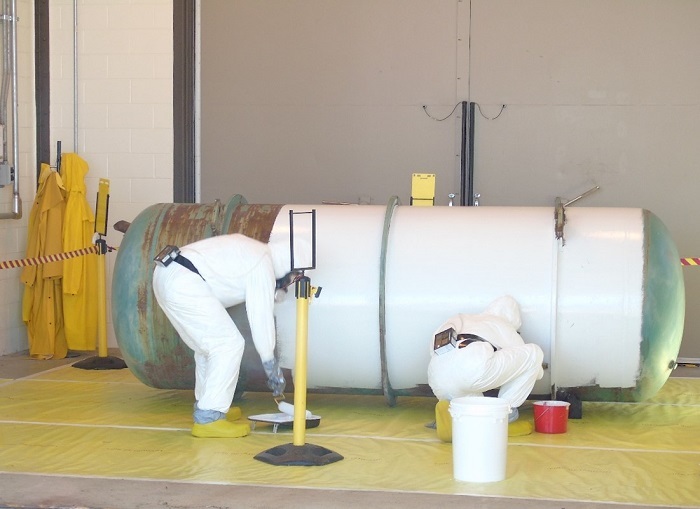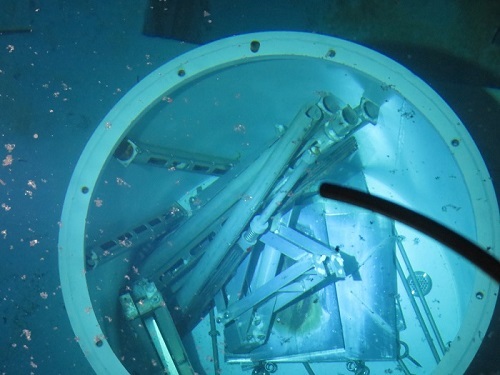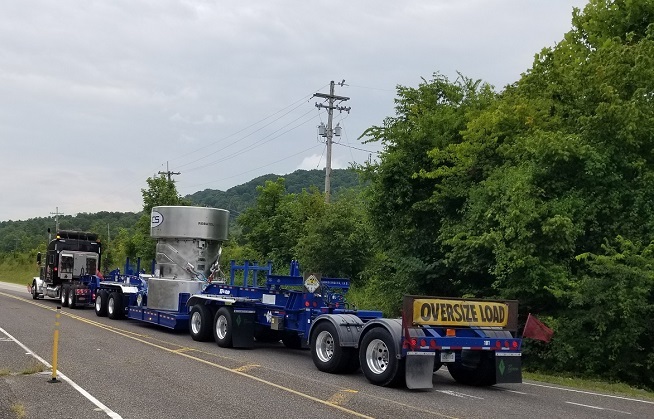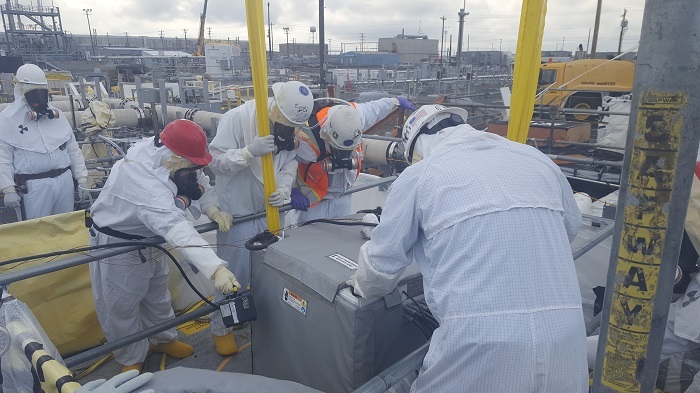 Workers with EM tank operations contractor Washington River Protection Solutions install remotely operated, specialized equipment to retrieve waste from single-shell tank AX-103 at the Hanford Site.
RICHLAND, Wash. – EM Office of River Protection tank operations contractor Washington River Protection Solutions (WRPS) recently began retrieving radioactive and chemical waste from another massive underground storage tank at the Hanford Site.
Over the next several months, workers will retrieve approximately 104,000 gallons of solid and sludge-like material from Tank AX-103 and transfer it to a double-shell tank for safe storage until it is fed to the Waste Treatment and Immobilization Plant for vitrification, or immobilization in glass. “Moving waste from older single-shell tanks to newer double-shell tanks is an important step in progressing our risk-reduction mission,” said Ricky Bang, Hanford EM Tank Farms Program division director. “It’s not easy to access the tanks or move this kind of waste, and it takes specialized tools and techniques that have been developed, tested, and proved successful to meet this challenge.” During waste retrieval, workers operate retrieval equipment inserted through relatively small openings in the top of the tank from a nearby control trailer. They use pressurized water to dissolve the solid, or salt-cake, waste and flush it to the pump that transfers the waste to a double-shell tank.
“It takes a particular combination of water and pressure to create a slurry, which suspends the heavier solids in a liquid that can be pumped out and sent via transfer lines to another tank,” said Peggy Hamilton, retrievals manager for WRPS. “We use lessons we learned and technologies developed during the successful retrieval of waste from other tanks to help us complete this challenging work.”
 To prepare decades-old tanks for efficient and safe waste retrieval operations, workers remove old systems and equipment, like this thermocouple that was used to measure the temperature of waste. They install new retrieval and monitoring equipment, ventilation safety systems, and waste transfer lines.
Tank AX-103 is the third million-gallon tank to have its waste retrieved in a group of four called the AX Tank Farm. WRPS has already retrieved waste from tanks AX-102 and 104. Retrieval of the last tank, AX-101, is scheduled to begin next year.
Preparing a decades-old tank farm for safe waste retrieval takes years of retrofitting. Workers remove old, contaminated equipment from the tank to make space for the equipment needed for retrieval of the waste. Then they install modern retrieval equipment, ventilation safety and leak-detection systems, and transfer lines to move the waste to a double-shell tank. They also install utilities and cameras with lighting so operators can see inside the tanks while operating equipment remotely.
To date, workers have completed retrieving the waste from 17 of Hanford’s 149 older single-shell tanks. Those tanks include the 16 tanks in the C Farm and a tank in the S Farm. Once tanks AX-102 and 104 go through a standard technical review for completion that can take several months, the list will grow to 19.
Hanford’s single-shell tanks were constructed of carbon steel and reinforced concrete between 1943 and 1964 to store radioactive and chemical waste created during plutonium production operations in World War II and the Cold War era.
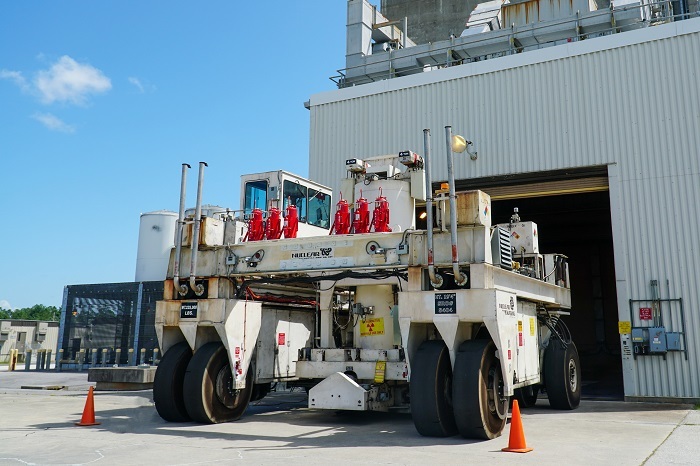 Savannah River Site employees recently upgraded the site’s shielded canister transporter with an advanced fire suppression system.
AIKEN, S.C. – EM has installed an improved fire suppression system on a one-of-a-kind Savannah River Site (SRS) vehicle that moves high-level waste canisters.
The shielded canister transporter (SCT) at SRS is a specially designed vehicle that is more than 18 feet tall, 25 feet wide, and weighs 235,000 pounds. It moves canisters of vitrified high-level waste produced at the Defense Waste Processing Facility (DWPF) to safe interim storage at the Glass Waste Storage Buildings (GWSB). The SCT also double-stacks stored canisters to increase storage capacity in one of those storage buildings. Each stainless steel canister is 10 feet tall and weighs approximately 5,000 pounds when filled.
SRS liquid waste contractor Savannah River Remediation (SRR) upgraded the fire suppression system on the SCT, including improvements to an operator’s ability to safely exit in the unlikely event of a fire emergency on the SCT. Due to the location of the SCT operator, the extensive radiation shielding blocking visibility to the engine compartments, and the engine noise created by SCT operations, the need for an automatic fire suppression system was identified as a necessary improvement.
SRR Chief Operating Officer and Deputy Project Manager Mark Schmitz said he is pleased with the work on the SCT, which was completed by SRR and small disadvantaged business contractor FQS Bear.
“Ensuring our high-level waste canisters are safely stored is part of the ownership SRR takes in the liquid waste mission at SRS,” Schmitz said. “Anything we can do to enhance safety is carefully evaluated and applied. This new system was engineered to be reliable and technically advanced, while meeting national fire protection standards.”
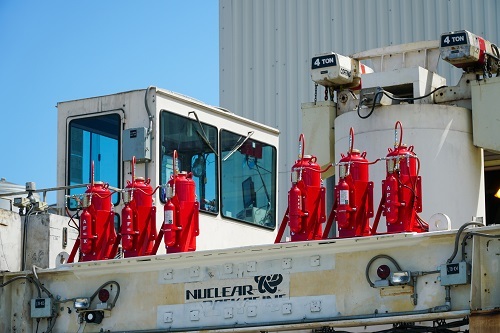 |
|
A view of the liquid agent tanks for the fire suppression system of the shielded canister transporter at the Savannah River Site. |
The permanently installed system on the SCT is designed for heavy-duty mobile equipment and consists of heat-detection devices for automatic activations, six liquid agent tanks, and control units for each of the SCT’s two engines. A system display is in the cab of the SCT, which shows the system status and allows for manual operation, if necessary.
DOE-Savannah River Assistant Manager for Waste Disposition Jim Folk said the SCT now has a system that has met rigorous testing standards for loss prevention.
“The SCT is a large and complex vehicle. Its importance to the execution of the liquid waste mission cannot be understated,” Folk said. “Having a certified fire protection system on this one-of-a-kind vehicle helps ensure we can continue to move canisters from DWPF to the GWSBs efficiently and safely.”
-Contributor: Ashley Dernberger
|


